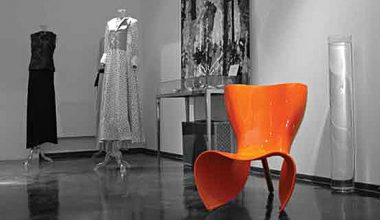

Held at GUST University, and over the course of 3 days, this year's Nuqat Design Conference focused on Visual Pollution in the Arab World. The event included speakers from various professions in the design field, such as graphic designers, artists, architects, and editors of design magazines.
It was an event that promised to "integrate several graphic design and architecture disciplines together in the aim to move the bar one level up."

It was a substantial promise to undertake, but one that was delivered in a very interesting and exciting manner.
Starting at 9:00 am every day, four speakers presented the audience with lectures that related to this year's theme. After each lecture, there was a period of Q&A, in which the audience participated in discussions (and sometimes debates!) regarding the topic that was presented. Lectures ended at 1:00pm, where there was a 1 hour lunch break, and workshops started at 2:00pm.

Every morning, waiters would serve handheld savory delights from Munch, while during the afternoon, guests were treated to mini sandwiches from Baking Tray. During the lunch break, in addition to the sandwiches, traditional Arabic food was made fresh outdoors, and served popular dishes such as fool and falafel sandwiches!
The entire space the event took place in was a delight. The building had plenty of natural light, glass ceilings and walls, and included an outdoor atrium. Nuqat also housed an exhibition in the building, which guests experienced during the breaks. Among those were Sketchbook Magazine, REUSE, Local Tees and art by Abdullah Al Awadhi and Farid Abdal.
When it came to the lectures, each one provided insight more valuable than the other. The first lecturer, Farid Abdal gave an eye opening presentation, about how modern infrastructure and redesign in Kuwait has wiped out some very culturally significant buildings in the country, and is continuing to do so.

Wafa Alobaidat, Bahraini creator of Sketchbook magazine, talked about the establishment and launch of her magazine. She spoke about how Sketchbook was launched, how they work, what it's become and how she's slowly transitioning it into the Khaleej, because it was and still is based in London. Also in the magazine industry is Ahmed Bin Shabib, Co-Founder of Brownbook magazine, who gave us insight on the importance of a strong magazine with core values. He believes it should stand the test of time, serve as a reference point, and one you keep coming back to.
"Spray It, Don't Say It" was the topic of choice for Tala Saleh, a Saudi artist and author of "Marking Beirut". She described how graffiti is a component of visual pollution in general, but has evolved in the Middle East, especially in Beirut, to become more significant especially during political situations.
A crowd favorite was graphic designer Tarek Atrissi, who presented us with a pleasant discussion about Arabic typography and Graphic Design in the Middle East. He focuses on cross-cultural design and works to implement modern techniques to improve poor design in the Arab world. Also among the favorites was artist Rana Salam, whose lecture "From Shaabi to Chic" provided us with colorful imagery and kitschy Arabic paraphernalia. She is a genius when it comes to creating something so pleasing to the eye out of something we might regard as junk. She infuses those kitschy items into her graphic design, and it translates beautifully into her work.

Mehdi Saeedi, a calligrapher and artist from Iran, got the audience completely awestruck with his stunning and intricate work. His handwork is utterly beautiful, using calligraphy to create silhouettes of animals and human bodies. He also surprised us with the advanced level and development of artwork in Iran.
The last day at Nuqat provided us with the important ideas to consider when it comes to architectural aesthetics. It was also one full of interesting discussions. Abdullah and Hamid Qabazard's lecture "Let There Be Night…!" was possibly the complete opposite of Tarek Al-Kanderi's "Can Not Enough Pollution be Visual Pollution?" While the first described how building design in Kuwait nowadays is a source of visual pollution, the latter described how the lack of buildings in a city IS the source of visual pollution. Finally, Ganzeer, graphic designer and Egypt's "enfant terrible", provided us with a humorous lecture called "Weird Ideas for Weirder Situations", in which he showed images of various design errors in his hometown of Cairo.

One of our favorite elements of the event was the fact that the presenters were easily accessible for the participants in the conference to chat with. The presenters mingled with attendees during the 10 minute breaks between lectures, as well as during the hour long lunch break. In addition, during the evenings, a screening of a locally produced film took place outdoors under the stars. Sitting on pink pillows and armed with popcorn, Zain Al-Sabah's film "Amreeka" was shown on the first day. On the second day, the audience was treated to the first screening of "Losing Ahmed" by filmmaker Abdullah Boushahri.
As far as conferences go, there is usually a misconception that they are stiff, boring and long. Nuqat's conference was quintessentially the opposite. The atmosphere was laid-back, the attendees as interesting as the lecturers, and the event as fascinating as promised. Our only remark, if any, has to be that we are not in favor of the Nuqat Design Conference being a "travelling" one.
The Nuqat team hinted that they would like the conference to take place in a different country every year. We, on the other hand, loved the idea that it was held in Kuwait, and would love for it to be a local event in which design enthusiasts from all over the Middle East (and the world) flock to. Here's to hoping!
By: Alya N. Al-Othman











